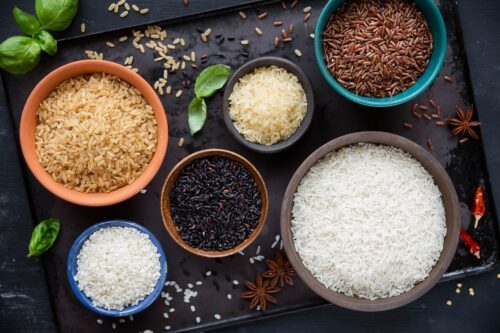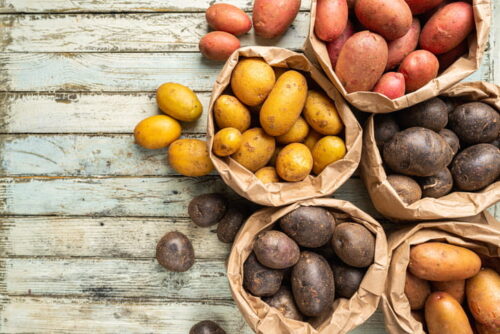Nuts Come in Hard Shells – For Reasons
Growing up in a low-income family in the suburbs of Detroit we had nuts once a year. At Christmastime my father brought home a 5-pound bag of mixed nuts all firmly encased individually in rock hard shells. Over the next five days, with the aid of a mechanical nutcracker and a steel pick, the six members of the McDougall family ate almonds, Brazil nuts, cashews, hazelnuts, pecans, and walnuts. These days, eating nuts is as convenient as unscrewing the lid of a glass jar, and then pouring an ounce of shelled, oil-roasted, nuts directly into your mouth. After seven chews and a swallow, in fewer than five seconds, 120 calories of fat are gulped down. Within three hours much of that fat is stored as metabolic dollars to be spent during the next famine.
Nuts (more accurately, tree nuts) act as “storage organs of energy” for a tree’s germ to sprout into a seedling and grow come springtime. Seeds, legumes, and grains serve the same purposes for their parent plants. One of the primary differences between these four organs for the origin of life is the amount of energy stored as either fats or carbohydrates. Nuts and seeds use mostly fats. Grains, such as corn, rice, and wheat, store their fuel as carbohydrates. Legumes, such as beans, peas, and lentils, also use carbohydrates for stored fuel. Peanuts, technically legumes, are typically included in the nut group because they have a similar nutrient makeup and are used in the same ways as tree nuts.
These storage organs are also rich in other nutrients, such as proteins, vitamins, minerals, and many other phyto-nutrients, important for the seedling’s growth. The high nutrient density of these packages also has a major impact on human health when consumed.
Primarily six foods (five of them grains): barley, maize (corn), millet, potatoes, rice, and wheat have fueled the caloric engines of human civilization. The bulk of the energy in these storage organ foods comes from carbohydrates. They contain only small amounts of fats. Human metabolism is designed to run primarily on carbohydrates, not fats. Proof of this begins with the recognition that the human tongue tastes with pleasure only one source of calories—carbohydrates—causing us to seek this goldmine of energy. There are no pleasure sensors for fats here. The primary digestive enzymes (amylases) in the human gut are for carbohydrates (starches), not for fats. Finally, almost exclusively, carbohydrates, not fats, fuel our major organs, including the blood, liver, kidneys, and brain.
In order for populations to survive individuals must function at peak physical and mental performance. To do less means a greater chance of conquest by invaders, being eaten by predators, succumbing to sicknesses, and annihilation by natural disasters. Laws of “survival of the fittest” dictate that those who are most productively fueled win.
Athletes have recently learned to choose foods that provide the most easily assimilated carbohydrates in the quickest time; those with a high glycemic index. The glycemic index measures the rise in blood sugar in a person over two to three hours after eating. Higher glycemic index foods replenish an athletes energy stores more efficiently than those with a low value. Winners have learned to choose the same foods that have fueled all large successful civilizations of the past—barley, corn, rice, potatoes, pastas, and breads. They do not choose nuts and seeds, which are deficient in carbohydrates, filled with fats, and are also low on the glycemic index scale (between 7 and 23). Rice, corn, and potatoes have values over 100. The relatively low scores of legumes (30 to 40) may be one important reason that they have rarely served as a primary food source for large societies.
In 2002, Mary and I were invited by a couple who had attended the McDougall (10-day live-in) Program in Santa Rosa, California to dine with them at the very popular raw-food restaurant, Roxanne’s, in Larkspur, California. We each had a non-alcoholic drink, an appetizer, a soup, an entrée, and a dessert. For my main course, I ordered the lasagna and Mary ordered the curry dish. The “cold” uncooked lasagna was about the size of four postage stamps and was made with raw cashew “cheese” and coconut “noodles.” I prolonged my mealtime by taking small bites. My usual size forkfuls would have left my plate empty in four bites. Halfway through dinner my host asked me how I was enjoying my meal. In my usual not so politically-correct manner, I responded, “Tasty, but this is barely enough food to get me to Taco Bell.” I understand one of the reasons for the small portion served. A full plate of Roxanne’s nutty lasagna would have meant a thousand calories just for my entrée. I am happy my host picked up the $500 check after the meal. Roxanne’s restaurant is no longer open.
A casual review of the scientific literature might lead the reader to conclude that eating nuts does not cause weight gain. How could eating so many concentrated fat calories be OK for any weight loss plan? A careful review of the methods used reveals that the trick is to restrict the subjects’ calorie intake and/or limit the amount of nuts they are allowed to eat to about an ounce a day.
Still, the addition of an ounce of nuts a day should cause some weight gain when the daily calories are otherwise unrestricted. An ounce of nuts means an additional 150 calories daily—that’s 4500 calories a month, which could represent a monthly gain of a pound and a half of body fat. Many reasons are given for this unexplainable effect of little or no weight gain with added nuts: the high satiety of nuts causes people to eat less, added nuts displace more fattening foods (cakes and pies), their monounsaturated and polyunsaturated fatty acids are more readily burned off (diet-induced thermogenesis), and an increase in fecal losses of fat due to incomplete mastication of whole nuts (nut butters would be much more readily digested and more fattening).
High-protein foods in Western diets, especially hard cheeses, meat, poultry, eggs, fish, shellfish, and foods made with isolated soy proteins, generate a large amount of acid in the body after eating them. This acid must be neutralized, primarily by the release of alkaline materials from the bones; and thus begins bone loss and osteoporosis.
The storage organs—nuts, seeds, legumes, and grains—are rich in nutrients, including proteins, which result in the delivery of a small net acid load to the body. (The amount of acid caused by animal food consumption is 6 to 10 times greater than that caused by plant storage organs.) A study of people on a Mediterranean diet supplemented with an ounce of nuts (walnuts, hazelnuts, and almonds) daily for three months, found evidence of adverse effects on their bones. There was an elevation in their parathyroid hormone levels and a slight increase in breakdown products of bone (deoxypyridinoline) found in the nut-eaters’ urine. However, most healthy plant-food-based meal plans also include foods that are alkaline, meaning fruits and vegetables, which neutralize the small amount of dietary acids that come from eating nuts, seeds, legumes, and grains. However, this observation should also serve as a word of caution that even a whole foods vegetarian diet has the potential to cause problems of over-nutrition from excess calories, fat, protein, and dietary acids, and adding in green and yellow vegetables and fruits is important.
We must eat, and when properly informed, we do have a choice when it comes to the amounts of carbohydrates and fats we consume. People are starch-eaters—meaning we thrive on a high-carbohydrate, low-fat diet. For our best appearance and performance we must remain true to our nature. However, most of us are also resilient. Thus, an occasional rich food is no serious threat for otherwise trim and healthy people—especially when this delicacy is from a whole plant origin, such as nuts. The problems begin when occasional holiday treats become the center of a meal plan everyday.
References:
1) American Dietetic Association; Dietitians of Canada; American College of Sports Medicine, Rodriguez NR, Di Marco NM, Langley S. American College of Sports Medicine position stand. Nutrition and athletic performance. Med Sci Sports Exerc. 2009 Mar;41(3):709-31.
2) Coyle EF. Substrate utilization during exercise in active people. Am J Clin Nutr. 1995 Apr;61(4 Suppl):968S-979S.
3) Rauch LH. The effects of carbohydrate loading on muscle glycogen content and cycling performance. Int J Sport Nutr. 1995 Mar;5(1):25-36.
4) Hawley JA. Strategies to enhance fat utilisation during exercise. Sports Med. 1998 Apr;25(4):241-57.
5) Helge JW. Impact of a fat-rich diet on endurance in man: role of the dietary period. Med Sci Sports Exerc. 1998 Mar;30(3):456-61.
6) Maughan R. The athlete’s diet: nutritional goals and dietary strategies. Proc Nutr Soc. 2002 Feb;61(1):87-96.
7) Ivy JL. Dietary strategies to promote glycogen synthesis after exercise. Can J Appl Physiol. 2001;26 Suppl:S236-45.
8) Hawley JA. Effect of meal frequency and timing on physical performance. Br J Nutr. 1997 Apr;77 Suppl 1:S91-103.
9) Walton P. Glycaemic index and optimal performance. Sports Med. 1997 Mar;23(3):164-72.
10) Foster-Powell K, Holt SH, Brand-Miller JC. International table of glycemic index and glycemic load values: 2002. Am J Clin Nutr. 2002 Jul;76(1):5-56.
11) http://www.living-foods.com/articles/roxannes.html
12) Natoli S, McCoy P. A review of the evidence: nuts and body weight. Asia Pac J Clin Nutr. 2007;16(4):588-97.
13) Remer T, Manz F. Potential renal acid load of foods and its influence on urine pH. J Am Diet Assoc. 1995 Jul;95(7):791-7.
14) Maurer M. Neutralization of Western diet inhibits bone resorption independently of K intake and reduces cortisol secretion in humans. Am J Physiol Renal Physiol. 2003 Jan;284(1):F32-40.
15) Remer T. Influence of diet on acid-base balance. Semin Dial. 2000 Jul-Aug;13(4):221-6.
16) Frassetto L. Diet, evolution and aging–the pathophysiologic effects of the post-agricultural inversion of the potassium-to-sodium and base-to-chloride ratios in the human diet. Eur J Nutr. 2001 Oct;40(5):200-13.
17) Spence LA, Lipscomb ER, Cadogan J, Martin B, Wastney ME, Peacock M, Weaver CM. The effect of soy protein and soy isoflavones on calcium metabolism in postmenopausal women: a randomized crossover study. Am J Clin Nutr. 2005 Apr;81(4):916-22.
18) Bulló M, Amigó-Correig P, Márquez-Sandoval F, Babio N, Martínez-González MA, Estruch R, Basora J, Solà R, Salas-Salvadó J. Mediterranean diet and high dietary acid load associated with mixed nuts: effect on bone metabolism in elderly subjects. J Am Geriatr Soc. 2009 Oct;57(10):1789-98.
Recommended Articles

How to Cook Beans

How to Cook Rice





